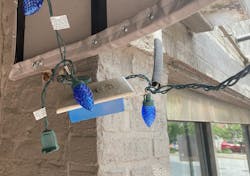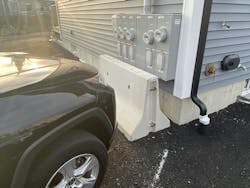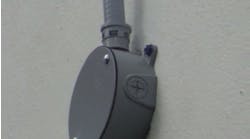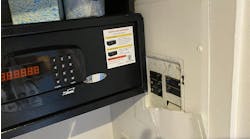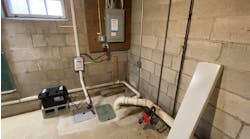All references are based on the 2023 edition of the NEC.
Awful Awning Lighting Installation
I spotted this hookup underneath an awning installed above the entranceway to a local business. There are many problems to point out here. The lack of support for the box is one big problem. The conductors are literally supporting the box. This does not comply with any of the box support requirements in Sec. 314.23(A)-(H).
Another huge problem with this installation is the lack of an equipment grounding conductor (EGC). The liquidtight flexible nonmetallic conduit (LFNC) only contains a black and white conductor. Section 406.4(B) requires an EGC to be connected to the grounding terminal of the duplex receptacle. This non-weather resistant duplex receptacle does not comply with either Sec. 406.(9)(A) for damp locations or Sec. 406.9(B) for wet locations. The enclosure for the duplex receptacle also does not comply with either of those two Sections.
Finally, the incomplete LFNC raceway does not comply with Sec. 300.12. The exposed THWN conductors are not sunlight resistant as specified in Sec. 310.10(D). Based on all the visible problems I can see here, I tend to doubt any GFCI protection is provided for this duplex receptacle as required by Sec. 210.8(B)(6). All in all, I think this is a pretty scary installation.
Good Intentions, Bad Outcome
Placing a concrete barrier in front of this brand-new electrical service was a good idea to protect the equipment from being damaged by vehicles parking near this building. It may have been an attempt to protect per Sec. 240.24(C). Unfortunately, the location of the concrete barrier should have been better planned out. Its present location is smack dab in the middle of the working space required by Sec.110.26(A). The location of this barrier is so close to the electrical equipment that it prevents the removable lift-up covers from being easily lifted up and out of the equipment. Thankfully, the flip-up covers for the circuit breakers can be fully opened at least —
otherwise, that would have been a nightmare if one of those breakers needed to be turned off in a hurry.
With the present layout, I would not consider these overcurrent devices as being readily accessible as required by Sec. 240.24(A). Sliding that concrete barrier out 3 ft could make for a Code-compliant installation, but, of course, that may cause problems with parking. A better solution needs to be found here.

